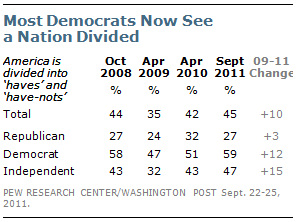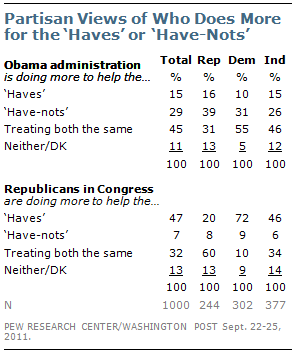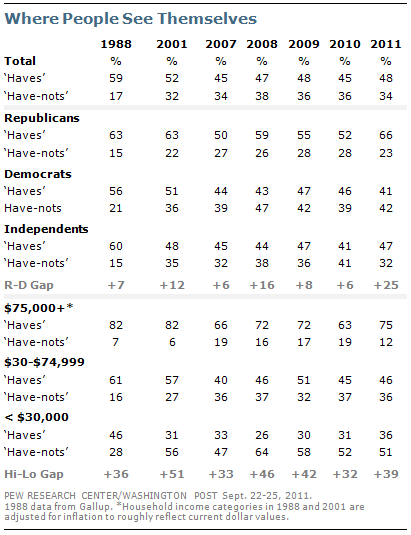
Despite an extended economic downturn, the public’s impression of whether the nation is economically divided remains relatively stable. While 45% say American society is divided between “haves” and “have-nots,” 52% say it is incorrect to think of the country this way. This is comparable to the balance of opinion a year ago.
The percentage of Americans who see society as divided between haves and have-nots declined shortly after Barack Obama took office, but has rebounded since. In April 2009, just 35% said the nation was divided economically, down from 44% in October 2008. The number saying the nation is economically divided increased to 42% a year later and has changed little since then (45% currently).

Since 2009, the percentage of independents saying the country is divided between haves and have-nots has risen 15 points, from 32% to 47%. There has been a comparable increase in the proportion of Democrats expressing this view (from 47% to 59%). Just 27% of Republicans see the nation as economically divided, which is largely unchanged from two years ago (24%).
While consistent with views over much of the past decade, the balance of opinion about economic division in the country stands in contrast to where it was a quarter century ago. In Gallup polls in the mid-1980s, far wider majorities rejected the idea that the

country was divided into haves and have-nots.
The latest survey by the Pew Research Center for the People & the Press and The Washington Post, conducted Sept. 22-25 among 1,000 adults, finds that 48% say that, if forced to choose, they are among the haves, while 34% say they are among the have-nots. This balance of opinion has changed little over the past six years. Over the longer term, however, the number seeing themselves in the have-nots has risen substantially. In 1988, half as many described themselves this way (17%) as is the case today (34%).
By two-to-one (29% vs. 15%), more Americans think the Obama administration does more to help the

have-nots than to help the haves, with a plurality (45%) saying it treats both groups about equally.
Public impressions of congressional Republicans are quite different: 47% say they are mostly helping the haves, while just 7% say they are mostly helping the have-nots; 32% say Republicans are treating both groups the same. Current assessments of the Republicans in Congress are similar to 2004 opinions of which group George W. Bush’s administration was doing more to help (47% the haves, 4% the

have-nots, 42% both about the same).
Interestingly, partisan differences are relatively modest in views of which groups the Obama administration is doing more to help. More Republicans, Democrats and independents say the administration is doing more to help the have-nots than the haves. By contrast, 72% of Democrats say the GOP mostly helps the haves, compared with 46% of independents and just 20% of Republicans.
Haves and Have-Nots: Long-Term Views

There long have been wide racial differences in views of whether the nation is economically divided. In the current survey, 73% of African Americans say the nation is divided between haves and have-nots, compared with 40% of whites.
When Gallup first asked this question in 1988, blacks were almost twice as like as whites to express this view (49% vs. 24%). There also have been persistent partisan and income differences in these opinions.

In 1988, far more Americans saw themselves as haves than have-nots (59% vs. 17%), but the balance of opinion has narrowed. In recent years, nearly half have placed themselves in the haves while slightly more than a third see themselves as have-nots.
While partisan differences in these self-assessments have fluctuated, income differences have been fairly consistent over time. In the current survey, 75% of those with family incomes of $75,000 or more say they are haves, compared with 46% of those with incomes of $30,000 to $75,000 and 36% of those with incomes of less than $30,000.




